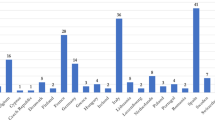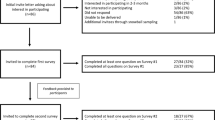Abstract
Today’s economic challenges and the changing landscape of clinical genetics are forcing us to consider alternative ways of providing genetic services, to comply with budget limitations and at the same time meeting the demands of increasing patient numbers and patient-centered care delivery. Telegenetics could be an effective and efficient way of counseling, but its use in Europe is not widely reported, nor is there evidence of international collaboration. We conducted an online survey among 929 genetics professionals, to explore the current availability and use of different telegenetics modalities in Europe. Our questionnaire was completed by 104 clinically active European genetics professionals. Telephone genetic counseling was used by 17% of respondents. Videoconferencing facilities were available to 24%, but only 9% of them used these for patient counseling. Various barriers to availability and use were cited, ranging from practical constraints, lack of professional support/knowledge, to lack of perceived suitability and need. The results show that telegenetics modalities are not currently in widespread use by our respondents, in part due to perceived barriers. To meet the changing economic, genetic, and societal circumstances, we recommend consideration of greater integration of telegenetics into regular clinical genetic care, to supplement existing care modalities. Professional cooperation, sharing knowledge, and establishing guidelines on a national and international level could contribute to successful and more widespread implementation of telegenetics. However, the perceived practical and regulatory barriers have to be overcome.
Similar content being viewed by others
Log in or create a free account to read this content
Gain free access to this article, as well as selected content from this journal and more on nature.com
or
References
Wade VA, Karnon J, Elshaug AG, Hiller JE : A systematic review of economic analyses of telehealth services using real time video communication. BMC Health Serv Res 2010; 10: 233.
Dellifraine JL, Dansky KH : Home-based telehealth: a review and meta analysis. J Telemed Telecare 2008; 14: 62–66.
Myers KM, Valentine JM, Melzer SM : Child and adolescent telepsychiatry: utilization and satisfaction. Telemed J E Health 2008; 14: 131–137.
Mehrota A, Paone S, Martich GD, Albert SM, Shevchik GJ : Characteristics of patients who seek care via evisits instead of office visits. Telemed J E Health 2013; 19: 1–5.
Merell RC : Editorial:Telemedicine for vulnerable populations. Telemed J E Health 2014; 20: 885–886.
Gray J, Brain K, Iredale R, Alderman J, France E, Hughes H : A pilot study of Telegenetics. J Telemed Telecare 2001; 7 (suppl 2): 68–70.
Iredale R, Gray J, Murtagh G : Telegenetics: a pilot study of video-mediated genetic consultations in Wales. Int J Med Market 2002; 2: 130–135.
Coelho JJ, Arnold A, Nayler J, Tischkowitz M, MacKay J : An assessment of the efficacy of cancer genetic counselling using real-time videoconferencing technology (telemedicine) compared to face-to-face consultations. Eur J Cancer 2005; 41: 2257–2261.
d’Agincourt-Canning L, McGillivray B, Panabaker K et al: Evaluation of genetic counseling for hereditary cancer by videoconference in British Columbia. BC Med J 2008; 50: 554–559.
Zilliacus E, Meiser B, Lobb E, Dudding TE, Barlow-Stewart K, Tucker K : The virtual consultation: practitionars’ experiences of genetic counseling by videoconferencing in Australia. Telemed J E Health 2010; 16: 350–357.
Hilgart JS, Hayward JA, Coles B, Iredale R : Telegenetics: a systematic review of telemedicine in genetics services. Genet Med 2012; 14: 765–776.
Aronson SJ, Clark EH, Varugheese M, Baxter S, Babb LJ, Rehm HL : Communicating new knowledge on previously reported genetic variants. Genet Med 2012; 14: 713–719.
Hunt K : Individualizing the Informed Consent Process for Whole Genome Squencing: A Patient Directed Approach [Dissertation]. Arizona: Arizona State University, 2013.
Hopper B, Buckman M, Edwards M : Evaluation of satisfaction of parents with the use of videoconferencing for a pediatric genetic consultation. Twin Res Human Genet 2011; 14: 343–346.
Elliott AM, Mhanni AA, Marles SL et al: Trends in Telehealth versus on-site clinical genetics appointments in Manitoba: a comparative study. J Genet Couns 2012; 21: 337–344.
Lea DH, Johnson JL, Ellingwood S, Allan W, Patel A, Smith R : Telegenetics in Maine: successful clinical and educational service delivery model developed from a 3-year pilot project. Genet Med 2005; 7: 21–27.
Stalker HJ, Wilson R, McCune H, Gonzalez J, Moffett M, Zori RT : Telegenetic medicine: improved access to services in an underserved area. J Telemed Telecare 2006; 12: 182–185.
Gardner MR, Jenkins SM, O’Neil DA, Wood DL, Spurrier BR, Pruthi S : Perceptions of video-based appointments from the patient’s home: a patient survey. Telemed J E Health 2014; 21: 281–285.
Bradbury AR, Patrick-Miller L, Fetzer D et al: Genetic counselor opinions of, and experiences with telephone communication of BRCA1/2 test results. Clin Genet 2011; 79: 125–131.
Madlensky L : Is it time to embrace telephone genetic counseling in the oncology setting? J Clin Oncol 2014; 32: 611–612.
Platten U, Rantala J, Lindblom A, Brandberg Y, Lindgren G : The use of telephone in genetic counseling versus in-person counseling: a randomized study on counselees’ outcome. Fam Cancer 2012; 11: 371–379.
Sutphen R, Davila B, Shappell H et al: Real world experience with cancer genetic counseling via telephone. Fam Cancer 2010; 9: 681–689.
Whitten P, Love B : Patient and provider satisfaction with the use of telemedicine: overview and rationale for cautious enthusiasm. J Postgrad Med 2005; 51: 294–300.
Grigsby B, Brega AAG, Bennett RE et al: The slow pace of interactive video Telemedicine adoption: the perspective of Telemedicine program administrators on physician participation. Telemed J E Health 2007; 3: 645–656.
Barton PL, Brega AG, Devore PA et al: Specialist physicians’ knowledge and beliefs about Telemedicine: a comparison of users and nonusers of the technology. Telemed J E Health 2007; 13: 487–499.
Acknowledgements
We thank Jerome del Picchia and Karin Knob from the European Society of Human Genetics, for providing e-mail addresses of ESHG members that were available for external use. We are also grateful to Silvia Mann and the other members of the NCC Telegenetics workgroup for giving us insight into their survey design, to Jackie Senior and Kate McIntyre for editing our manuscript, and to all the respondents for their participation.
Author information
Authors and Affiliations
Corresponding authors
Ethics declarations
Competing interests
The authors declare no conflict of interest.
Rights and permissions
About this article
Cite this article
Otten, E., Birnie, E., Lucassen, A. et al. Telemedicine uptake among Genetics Professionals in Europe: room for expansion. Eur J Hum Genet 24, 157–163 (2016). https://doi.org/10.1038/ejhg.2015.83
Received:
Revised:
Accepted:
Published:
Issue date:
DOI: https://doi.org/10.1038/ejhg.2015.83
This article is cited by
-
Patient experiences in receiving telegenetics care for inherited cardiovascular diseases
Journal of Community Genetics (2023)
-
Barriers and strategies to integrate medical genetics and primary care in underserved populations: a scoping review
Journal of Community Genetics (2021)
-
A pilot eConsultation service in Eastern Ontario: bridging clinical genetics and primary care
European Journal of Human Genetics (2019)
-
Factors influencing use of telegenetic counseling: perceptions of health care professionals in Sweden
Journal of Community Genetics (2019)
-
Implementing a Virtual Health Telemedicine Program in a Community Setting
Journal of Genetic Counseling (2018)



